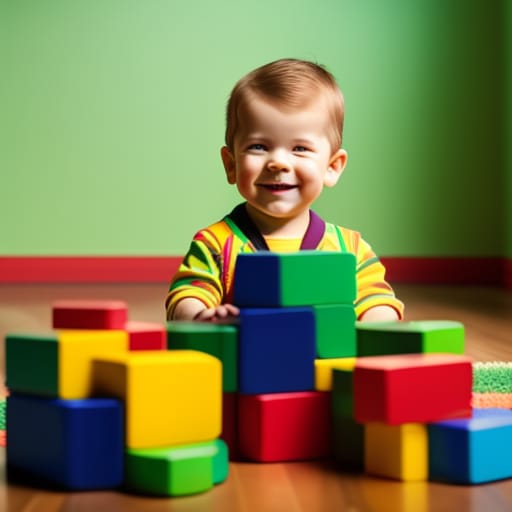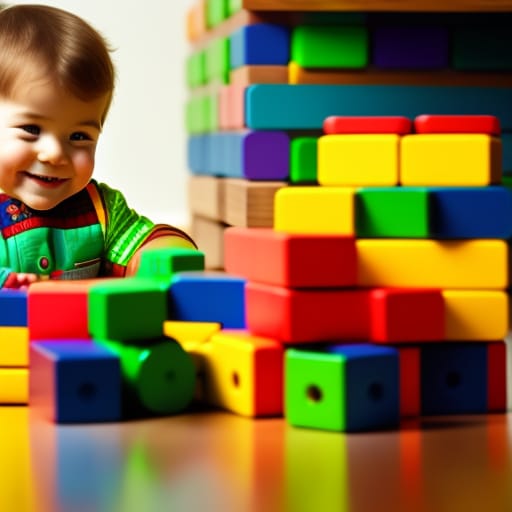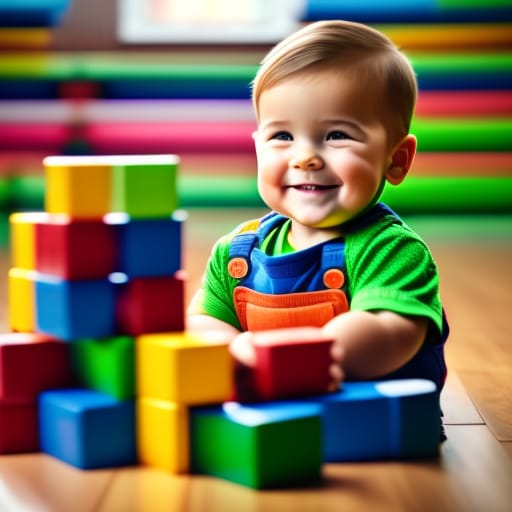Magnetic building blocks are a fun and educational toy for toddlers, preschoolers, and young children. These colorful blocks connect through magnetic forces to allow kids to build endless 3D creations and structures.
In this beginner’s guide, we will explore the benefits of magnetic building blocks, the different types available, tips for choosing the right set, and how to use them for maximum educational play.

What Are Magnetic Building Blocks?
Magnetic building blocks are a variation of traditional building blocks made of plastic, wood, or foam. Each block contains magnets arranged in a specific polarity so they attract and connect.
This allows the blocks to attach firmly in different configurations. Kids can stack the blocks vertically and horizontally to create sculptures, buildings, vehicles, and more.
Unlike normal blocks that rely on gravity and balance, the magnetic forces let these blocks attach at angles and upside down. This opens up endless possibilities for fostering 3D thinking, creativity, and imagination.
Magnetic building blocks are designed to inspire open-ended play and exploration. Rather than following step-by-step instructions, kids are encouraged to experiment with magnetism and geometry to build their own unique structures.
This hands-on learning delivers a range of developmental benefits that make magnetic blocks a top toy choice for parents, teachers, and therapists.
Benefits of Magnetic Building Blocks
Magnetic building blocks offer a wealth of benefits that support children’s growth and learning in critical developmental areas.
Develop Spatial Thinking and Geometry Skills
As children play with linking the blocks together in different angles and orientations, they improve their spatial reasoning abilities. Recognizing and manipulating 3D forms promotes an intuitive understanding of geometry concepts like balance, shape, and symmetry.
Table: Geometry and Spatial Skills Developed with Magnetic Blocks
| Skill | Description |
|---|---|
| 3D Thinking | Stacking blocks vertically and horizontally promotes visualization of 3D forms. |
| Shape Recognition | Identifying distinct shapes like cubes, pyramids, etc. improves shape knowledge. |
| Symmetry | Building mirrored or symmetrical patterns reinforces the concept of symmetry. |
| Geometry | Connecting blocks at angles demonstrates core geometry principles in action. |
This tangible learning forms an excellent foundation for more advanced STEM subjects later on.
Spark Creativity and Imagination
Instead of following limiting step-by-step instructions, magnetic blocks set kids free to build anything they can imagine. There are no limits besides the number of blocks available.
Children engage in open-ended play creating unique structures like castles, robots, spacecrafts, animals, or abstract art pieces. This self-directed experience promotes creativity, problem-solving, and confidence.
Develop Fine Motor Skills
The process of handling and manipulating the magnetic blocks helps improve children’s dexterity and fine motor skills. Actions like grasping, stacking, and separating blocks all involve concentration and controlled finger and hand movements.
As kids repeat these actions during play, it builds muscle strength, hand-eye coordination, and precision. Over time, their motor skills become more refined and adept.
Reinforce Early STEM Concepts
In addition to spatial skills, magnetic blocks provide hands-on experience with foundational science, technology, engineering, and math concepts including:
- Magnetism – understanding attractive and repulsive forces
- Polarity – how magnets connect based on their orientation
- Counting – counting blocks, sets, and pieces of creations
- Sorting/Classifying – grouping blocks by color, shape, or size
- Sequencing – arranging blocks in structured patterns
- Measuring – visualizing length and height with block units
- Stability/Forces – balancing blocks and experiencing gravity, tension, and stress forces
- Engineering – planning and constructing stable structures
Experiencing these STEM basics through play provides a strong basis for continued success and interest.
Promote Collaboration and Communication
Magnetic blocks are a great choice for social play between siblings, friends, classmates, or parent and child. Working together to build shared creations involves key skills like:
- Collaboration – planning, sharing ideas, and cooperating toward a common goal
- Communication – discussing ideas and expressing thoughts verbally
- Negotiation – compromising and resolving differences or conflicts
Practicing these prosocial behaviors develops children’s socio-emotional intelligence and teamwork abilities.
Provide Therapeutic Benefits
The multi-sensory, creative nature of magnetic block play offers these therapeutic benefits:
- Improves focus and attention span
- Calms and reduces stress/anxiety
- Channels energy in a positive direction
- Builds self-esteem and a sense of accomplishment
This makes magnetic blocks a useful therapy tool for autism, ADHD, anxiety disorders, and other conditions. The blocks appeal to a broad range of ages and skill levels.
With so many advantages, it’s easy to see why magnetic blocks rank among the best educational toys for young kids.
Types of Magnetic Building Blocks
There are a few main varieties of magnetic building blocks to consider:
Magnetic Tiles
- Geometric 2D magnetic tiles in circles, squares, triangles
- The flat shape allows layering into 3D forms
- Often have printed patterns like roads, train tracks, etc.
- Great for beginners ages 1-3 years old
Magnetic 3D Blocks
- 3D magnetic cubes or prisms
- Allow connecting in more directions than tiles
- Varying sizes like small 1cm cubes or large 5cm cubes
- Suit ages 1.5-5 years generally
Magnetic Balls and Rods
- Small magnetic balls and cylindrical rods
- Manipulate into 3D lattices, jewelry, or flexible sculptures
- Require more dexterity so suit ages 3+ years
- Warning: choking hazard for kids under 3
XL Magnetic Blocks
- Extra large magnetic cubes measuring 5cm and up
- Build bigger structures faster
- Often have textured sides for grip
- Allow collaborative building
- Best for ages 3-6 years
Specialty Sets
- Themed magnetic sets like PowerClix Solids
- Special shapes like long sticks, arches, and wheels
- Encourage copying structures from picture cards
- Add more play variety for ages 3+ years
Consider your child’s age, dexterity, and interests when choosing magnetic blocks. Many larger sets include various block types to allow open-ended building as skills progress.

Top Magnetic Building Blocks for Toddlers
Toddlers from 1-3 years old benefit most from simple magnetic tile and block sets that are easy to handle and manipulate. Here are 5 top-rated options:
1. PicassoTiles 30PCS Magnetic Building Tiles Set
- 30 colorful 2D magnetic tiles
- Triangles, squares, rectangles
- Patterns like roads and river streams
- $24.95 on Amazon
2. Magna-Tiles Clear Colors 100 Piece Set
- 3D transparent magnetic shapes
- Cubes, pyramids, squares, triangles
- Inspires creativity and open play
- $59.40 on Amazon
3. Magformers Basic Set (30 pieces)
- 30 magnetic 3D squares
- Guide diagrams for building ideas
- Opportunities for STEM learning
- $29.99 on Amazon
4. Tegu Magnetic Wooden Block Set
- 14 magnetic wooden blocks
- Modern aesthetic
- Natural material engages the senses
- $49.99 on the manufacturer’s site
5. Playmags Magnetic Building Set
- 49 pieces including wheels, cubes, panels
- Sturdy construction for stability
- Promotes imaginative play
- $43.95 on the manufacturer’s site
Focus on sets with larger, chunkier pieces that are easy for little hands to handle and manipulate. Blocks with patterns or textures provide added visual interest and inspiration for play.
How to Choose Magnetic Blocks for Your Child
Keep these tips in mind when selecting magnetic building blocks for kids:
Age-Appropriate Size and Dexterity
- Under 2 years – Pick large, basic tiles or blocks that are easy to grasp and stack
- Ages 2-3 – Look for a mix of different 2D and 3D magnetic shapes
- Ages 4-6 – Opt for small and large pieces to challenge dexterity
- Ages 7+ – Choose advanced sets with balls, rods, and sticks to build more intricate sculptures
Safety and Quality
- Ensure blocks are non-toxic and meet Consumer Product Safety Commission standards
- Read labels and avoid small parts under 3 years old due to choking hazard
- Select thick, durable pieces backed by a guarantee
- Magnets should be fully encased in the blocks
Inspire Specific Skills
- For creativity, choose sets with unique specialty shapes like arches or wheels
- For STEM learning, look for guided activity cards and sorting trays
- For therapy, opt for basic tangram or pyramid shapes
Developmental Extensibility
Ideally, select a set that offers opportunities to start simple and then build more advanced structures as your child’s skills develop.
Budget
- Smaller basic sets of 30-50 pieces run $25-$50
- Intermediate sets of up to 100 pieces range from $50-$100
- Large deluxe sets with 200+ pieces cost $100-$200
Look for high-quality sets that will last for years of play. Well-designed magnetic blocks can be passed down to younger siblings too.

Playing with Magnetic Blocks
Once you’ve chosen the right magnetic building blocks, here are some top tips for playing with them:
- Start by exploring how the magnets connect, stack, and align. Let your child freely experiment.
- Suggest starting with simple structures like cubes, houses, and trains to grasp the basics.
- Resist the urge to direct play. Instead, ask open questions like “What are you making?” and “What could we add next?”
- Add natural elements like sticks, rocks, and pom poms to incorporate science.
- Use magnetic blocks to model storytelling by having kids build scenes.
- Sort blocks by color, shape, or size to reinforce categorization skills.
- Store magnetic blocks in a bin or bag instead of rigid boxes to encourage creative thinking.
- Supervise play with small magnetic balls and rods which pose a choking risk for ages under 3 years.
Keep an open mind and let your child lead the experience. Magnetic play should be about free experimentation, not following rigid steps.
Frequently Asked Questions
Are magnetic building blocks safe for children?
Magnetic blocks are safe provided parents follow the recommended age guidelines and supervise play. Avoid small magnet ball/rod sets for kids under age 3 due to ingestion and choking hazards.
What are the best magnetic building blocks for toddlers?
For toddlers, choose large, chunky magnetic tiles or blocks with simple geometric shapes. Look for durable blocks made of BPA-free plastic or wood. Popular toddler brands include Magna-Tiles, Picasso Tiles, and Magformers.
How can magnetic blocks help teach STEM concepts?
Hands-on play with magnetic blocks lets kids explore principles of magnetism, polarity, geometry, balance, patterns, sequencing, counting, sorting, and spatial reasoning. This engages them in foundational STEM learning.
Are magnetic blocks good for autistic children?
Yes, magnetic blocks are commonly used in therapy for autistic children. The sensory properties and cause-effect interactions provided by magnetic blocks help develop fine motor skills, creativity, focus, and social interaction.
How should magnetic building blocks be cleaned and stored?
Use mild soapy water or baby wipes to clean magnetic blocks as needed. Make sure pieces are completely dry before storing. Store in a bin or bag in a cool, dry place away from direct sunlight to preserve magnetism.
Enjoy Endless Creativity with Magnetic Building Blocks
Magnetic building blocks inspire open-ended play that stimulates spatial thinking, creativity, imagination, and early STEM skills. With so many options available, select blocks suited for your child’s age and developmental needs.
The educational benefits and unlimited play potential make magnetic blocks a toy kids will return to over and over. Build your child’s skills the fun way by exploring the magical world of magnetic building blocks today!
For more developmental toy ideas, see:
Frequently Asked Questions
Are magnetic building blocks safe for children?
Magnetic blocks are safe provided parents follow the recommended age guidelines and supervise play. Avoid small magnet ball/rod sets for kids under age 3 due to ingestion and choking hazards.
What are the best magnetic building blocks for toddlers?
For toddlers, choose large, chunky magnetic tiles or blocks with simple geometric shapes. Look for durable blocks made of BPA-free plastic or wood. Popular toddler brands include Magna-Tiles, Picasso Tiles, and Magformers.
How can magnetic blocks help teach STEM concepts?
Hands-on play with magnetic blocks lets kids explore principles of magnetism, polarity, geometry, balance, patterns, sequencing, counting, sorting, and spatial reasoning. This engages them in foundational STEM learning.
Are magnetic blocks good for autistic children?
Yes, magnetic blocks are commonly used in therapy for autistic children. The sensory properties and cause-effect interactions provided by magnetic blocks help develop fine motor skills, creativity, focus, and social interaction.
How should magnetic blocks be cleaned and stored?
Use mild soapy water or baby wipes to clean magnetic blocks as needed. Make sure pieces are completely dry before storing. Store in a bin or bag in a cool, dry place away from direct sunlight to preserve magnetism.
What skills do magnetic building blocks improve?
Magnetic blocks help build skills like 3D thinking, shape recognition, symmetry, geometry, creativity, imagination, fine motor control, focus, collaboration, communication, problem-solving, and foundational STEM concepts through hands-on play.
What are the different types of magnetic building blocks?
Common types include 2D magnetic tiles, 3D magnetic cubes/prisms, magnetic balls/rods, extra large magnetic blocks, and themed sets with specialty pieces like arches or wheels. Different sets suit varying age groups.
How do I choose the right magnetic blocks for my child’s age?
- Ages 1-2: Large, basic tiles or blocks
- Ages 2-3: Mix of 2D and 3D shapes
- Ages 4-6: Small and large pieces
- Ages 7+: Advanced sets with balls, rods, sticks
Choose based on dexterity, safety, specific skills targeted, and budget.
Can I build STEM skills with magnetic blocks?
Yes, magnetic blocks are a great way to engage kids in early STEM concepts like magnetism, geometry, polarity, counting, sorting, sequencing, measurement, stability, engineering, and more through interactive play.